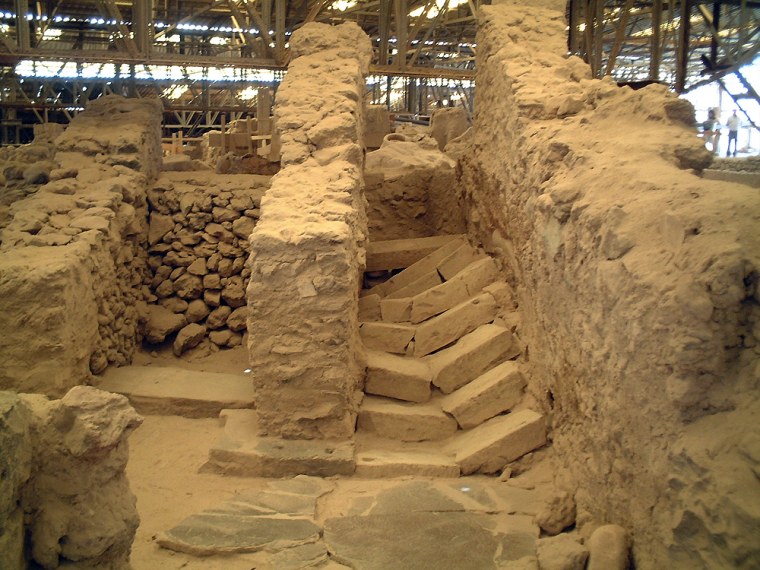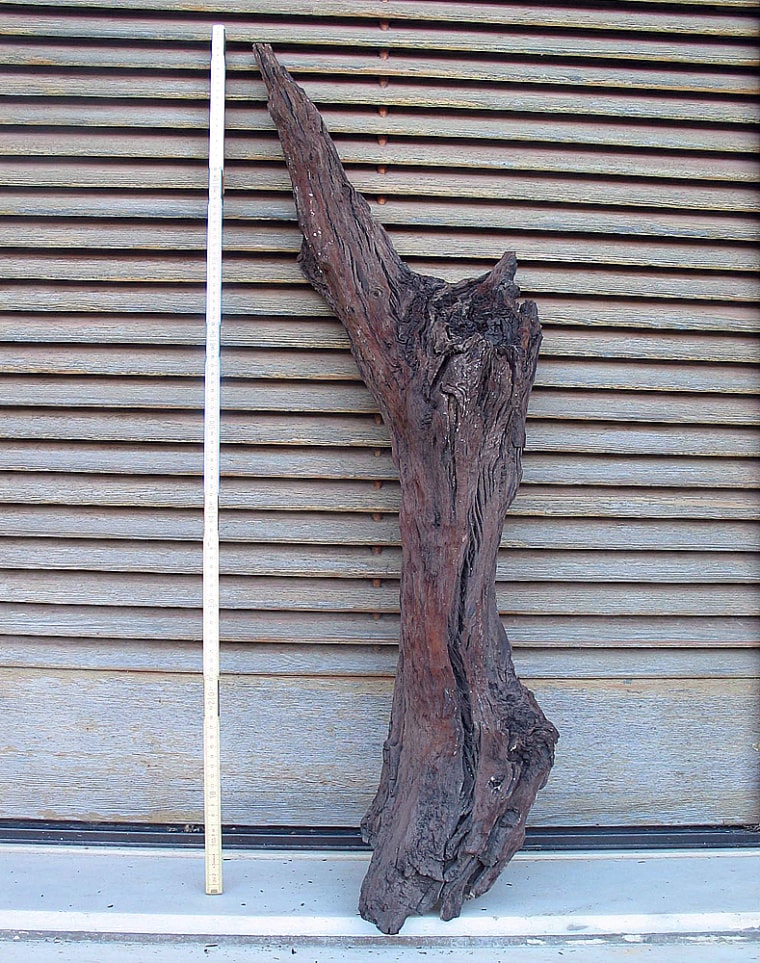Compared to the well-studied world of Homer’s Iliad and Odyssey, the civilizations that flourished in the eastern Mediterranean just before Homer’s time are still cloaked in mystery.
Even the basic chronology of the region during this time has been heatedly debated. Now, a resolution has finally emerged -- initiated, quite literally, by an olive branch.
Scientists have discovered the remains of a single olive tree, buried alive during a massive volcanic eruption during the Late Bronze Age. A study that dates this tree, plus another study that dates a series of objects from before, during and after the eruption, now offer a new timeline for one of the earliest chapters of European civilization.
The new results suggest that the sophisticated and powerful Minoan civilization (featured in the legend of Theseus and the Minotaur) and several other pre-Homeric civilizations arose about a century earlier and lasted for longer than previously thought.
The new timeframe also downplays Egypt’s role in the region, suggesting that the cultures of the Levant, the stretch of land that includes Syria, Israel and Palestine, may have been a more important outside influence.
The pair of studies appears in the 28 April issue of the journal Science, published by AAAS, the nonprofit science society.
During the Late Bronze Age, large building complexes appeared on Crete and later on mainland Greece as part of the Minoan “New Palace” civilization. At its high point, this civilization seems to have been the dominant cultural and economic force across the region, as the result of trade rather than military strength.

On Santorini, a major prehistoric settlement called Akrotiri was buried by the Minoan eruption, preserving what’s often called “the Pompeii of the Aegean.” Archeologists have uncovered three- and four-story houses and many other finds there, including an extraordinary collection of wall paintings that offer a glimpse into Minoan life. Women apparently played important civic and religious roles, including joining men in the sport of “bull-leaping,” which seems to have been religiously significant and as dangerous as the name implies.
The people of the Shaft Grave culture on mainland Greece, meanwhile, are known for burying their rulers with an eye-catching array of weapons, tools, pottery and other gold-rich ornaments. One grave contained a face mask that was originally identified as that of Agamemnon, the legendary king of Mycenae who led the Greeks against Troy in the Iliad.
The new findings suggest that it belonged to an earlier chief or king instead.
Also around the same time, major new coastal political systems were growing on Cyprus, fuelled by the island’s important copper industry that supplied the metal-hungry civilizations in the east Mediterranean.
Rethinking the timeline
It’s generally thought that these cultural developments in the eastern Mediterranean occurred during the 16th century B.C., along with the New Kingdom period in Egypt, when Egypt expanded its influence into western Asia.
The new studies suggests that these developments probably took place instead during the preceding “Second Intermediate Period,” when Egyptian power was weak and a foreign Canaanite dynasty even conquered northern Egypt for a while.
According to the new chronology, the Late Bronze Age civilizations in the Aegean and on Cyprus may have developed in association with 18th- and 17th-century Canaanite and Levantine civilizations and their expanding maritime trade world. These cultures were very different from the Egyptians’ in terms of culture, language and religion.
“If the papers published this week in Science are correct, then a critical new historical context may explain aspects of the development, languages, literature, religion and mythology of the Aegean and the later Classical worlds,” said Sturt Manning of the Cornell University and the University of Reading in the United Kingdom, who is the lead author of one of the studies.
The great debate
For more than a century, archaeologists have developed the chronology for this region by painstakingly comparing the various civilizations’ artifacts and artistic styles, such as how spirals were painted on pots or how metalwork was done. To pin the cultural periods to calendar dates, they then linked them to the accepted dates for the Egyptian pharaohs.
Since the 1970s, scientists have been measuring radiocarbon dates from the same areas, which don’t match with this artifact-based timeframe. Because of uncertainty about the dating methods, however, the radiocarbon results haven’t been convincing enough to overturn the archaeologists’ conclusions.
“It’s probably the biggest controversy in eastern Mediterranean archeology,” Manning said.
There has also been an inertia factor. Manning noted that if the existing chronology were wrong, it would mean rewriting the dates in museums and textbooks. And, it would have a more far-reaching effect, requiring a rethinking of some of the basic assumptions about the origins of European history.
“You would have a concertina effect, since you can’t move one part without upsetting the whole apple cart. Thus, it has been said that rewriting the chronology is impossible,” Manning said.
The 'Pompeii of the Aegean'
During the Minoan eruption, the volcano on what is now Santorini spewed ash and rocky debris up to hundreds of kilometers around. It was one of the largest eruptions in recorded history, and some researchers have even proposed that it was the basis for the legend of Atlantis.
The widespread volcanic ash layer offers a reference point that could potentially help line up the ages of various sites in the eastern Mediterranean, but researchers have not been able to date the layer precisely enough until now.

A remarkable solution to the problem emerged when Walter Friedrich and his graduate student Tom Pfeiffer, both of the University of Aarhus in Denmark, found the branch of an olive tree that was buried in its living position by the ash. The remains of the tree’s bark, leaves and twigs showed that the tree was still alive at the time of the eruption.
“I’ve been working on Santorini for 30 years and this is the first time I have seen such a thing,” Friedrich said.
By analyzing and dating the tree rings, Friedrich’s research team was able to pinpoint the age of the eruption more precisely than ever before, since the outermost ring was formed in roughly the same year that the volcano erupted.
The new timeframe for the eruption is between 1627 and 1600 B.C., a century earlier than archaeological studies have suggested.
“This was one of the biggest eruptions known to mankind, and now we have a precise date for the first time,” Friedrich said.
Before and after the eruption
The new age for the eruption fits in neatly with a much larger series of radiocarbon dates put together by Sturt Manning and his colleagues.
Manning’s team collected a large number of seeds and some tree-ring samples from a 300-year time span that included the Minoan eruption. They put together sets of data in a known sequence from before, around, and after the eruption and used sophisticated statistical methods to define new, more precise dates than before.
Given past controversy, they took a number of precautions, such as analyzing the seeds at two separate labs, to reduce the uncertainty of the earlier radiocarbon studies. The picture now from the radiocarbon seems fairly clear, according to Manning, but in conflict with the established dates and history.
Overall, the radiocarbon results indicate that the formation and high point of the New Palace period of Crete, the wall paintings of Akrotiri, the Shaft Grave period of the Greek mainland, and the political changes on Cyprus all occurred before approximately 1600 B.C. This is not only about 100 years earlier than thought; it also implies that the overall cultural era involved lasted much longer than researchers had assumed.
The new chronology makes the world of New Palace Crete even more important and interesting, Manning said, turning the later 18th and 17th centuries B.C. into an exciting new “cultural cauldron” from which significant elements of European history may have originated.
